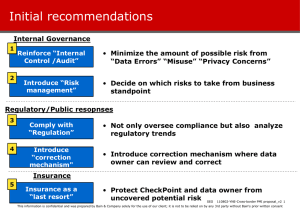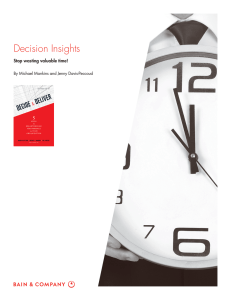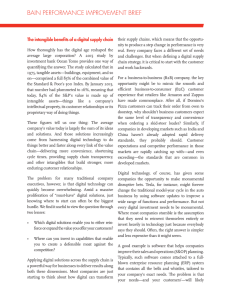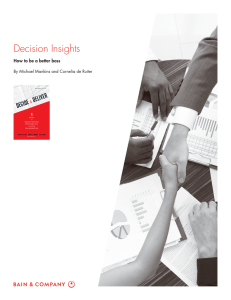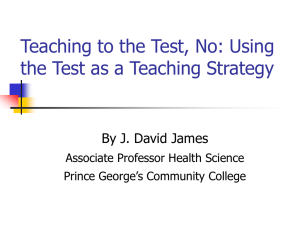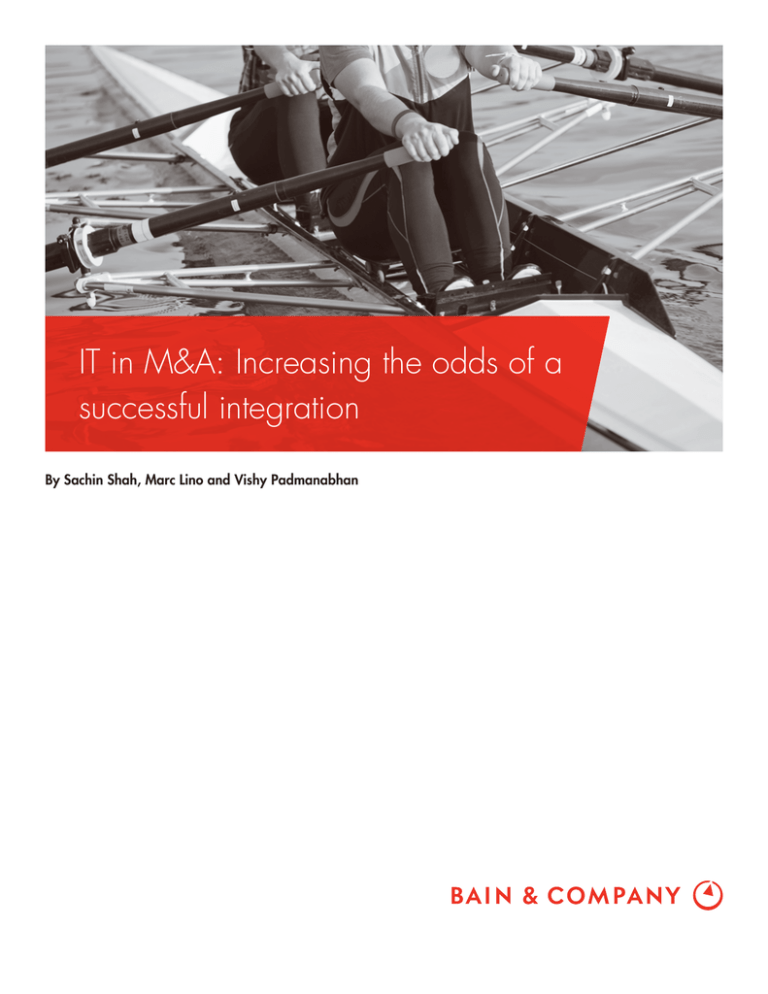
IT in M&A: Increasing the odds of a
successful integration
By Sachin Shah, Marc Lino and Vishy Padmanabhan
Sachin Shah is a partner with Bain & Company in London. Marc Lino is a Bain
partner in Amsterdam, and Vishy Padmanabhan is a partner in Bain’s Dallas
office. All three partners work with Bain’s Global Information Technology practice.
Copyright © 2014 Bain & Company, Inc. All rights reserved.
IT in M&A: Increasing the odds of a successful integration
In every merger or acquisition, companies integrating
their IT systems face two conflicting needs. The business wants to start cross-selling the products and services
of the newly combined organization as quickly as possible to increase revenues. IT, taking a longer-term view,
wants to invest the time and effort to integrate the combined organization’s systems effectively. Both goals are
critical to merger success—and the sooner they happen,
the quicker IT can begin generating incremental value
for the new business (see Figure 1).
In successful IT integrations, executives work quickly
to determine which decisions are most important, and
how to make those decisions quickly. This reduces uncertainty about how the company will integrate its platforms and what the end state will look like.
But too often, executives lose valuable time in the early
weeks and months after a deal completes by taking too
long to decide on critical issues, such as which platforms
the new organization will run on and the best approach
to IT integration. Often they focus on the wrong issues,
including lower-priority projects like merging email,
intranets or other systems that could continue to run
independently or with patched connections without
slowing down the new business.
•
By the end of the first month, they should have a
clear idea of the company’s IT integration goals
and hypothesis (see Figure 2).
•
At the end of three months, they should know the
shape and makeup of the future integrated application systems platforms, as well as how much they
will need to invest and where they will get the resources. By this time, they should also know where
integration is most important, which systems can
continue to run independently and where interface
connections are good enough for a while. They
should also have defined the benefits they expect
and how to manage the implementation risks.
Figure 1: IT integration must balance short- and long-term business integration goals
High
Delivering on short-term revenue goals
Longer-term IT strategy for integrated business
• Critical to build confidence in deal rationale
• Combined business requires ongoing investment
in IT capabilities, beyond integrated systems,
to continue growth trajectory
• May require short-term tactical IT solutions at
expense of IT integration
Short-term
urgency
Low
Preparing IT for Day 1 operations
Long-term, sustainable cost and revenue synergies
• Symbolic importance
• Requires integrated IT application system platforms
• Limited impact on business’s ability to
continue operations
• Takes two to three years and needs
significant investment
High
Low
Long-term importance
Source: Bain & Company
1
IT in M&A: Increasing the odds of a successful integration
Figure 2: A successful IT integration begins with the integration hypothesis and stresses the importance
of choosing the right applications platform and organizational structure
IT integration hypothesis
Synergies
Applications
Infrastructure
Networks
and telecoms
End-user
computing
Suppliers
and contracts
Organization
IT integration initiatives
Business integration initiatives
Source: Bain & Company
•
After the first year, the integrated systems should
be delivering at least half the value in cost and revenue synergies, as envisioned by the merger deal
thesis. Full integration should be completed within two or three years.
nance model of the post-merger organization will also
help determine who makes those decisions. When one
dominant partner is acquiring another, decision making tends to be easier (and quicker) than in a merger
of equals.
Defining the goals of integration
Getting this right is more important than ever, as low
interest rates and abundant capital spur more M&A
activity. The rewards are worth the effort: Bain’s research
finds that companies that take part in M&A deliver higher
total shareholder returns (4.8%) than those that stay on
the sidelines (3.3%). (For more details, see the Bain
Brief “The renaissance in mergers and acquisitions:
The surprising lessons of the 2000s.”) Given IT’s critical role in determining whether mergers deliver their
expected value, the key strategic decisions belong not
only to IT executives but also to CEOs and other senior
executives. Ideally, senior IT executives should make
the recommendations and then work with the CEO and
other senior managers to make decisions. The gover-
The first step in a successful merger of IT organizations—one that is often overlooked—is to determine IT’s
role in supporting the deal thesis. This important first
decision clarifies the business value that IT will contribute to the merger (see Figure 3). Once the business integration principles are clear, they create a solid
foundation on which to make other decisions.
With the business integration goals clear, the team can
decide on the platform that best equips the company
for future success—whether that’s using one company’s
systems, employing a hybrid mix from both or continu-
2
IT in M&A: Increasing the odds of a successful integration
Figure 3: IT-dependent synergies contribute 30% to 60% of a merger’s benefits
Recent Bain experience
Merger synergies
100%
Other
synergies
80
60
Other
synergies
Other
synergies
IT-dependent
synergies
IT-dependent
synergies
40
20
IT-dependent
synergies
IT-dependent
synergies
IT synergies
IT synergies
IT synergies
IT synergies
Deal C
Deal D
0
Deal A
Deal B
Source: Selected merger integration projects that Bain has worked on
ing to run each company’s systems independently. With
that decision made, others about infrastructure, organization, suppliers and outsourcing become easier to make.
decided to move all of Cadbury’s business to Kraft Food’s
platforms because they were more modern and supported multiple operating models, and Kraft Foods was
twice the size of Cadbury. Kraft Foods also had a good
track record of consolidating and implementing its systems. Within a year, the combined company had achieved
half of its intended integration synergies, and the entire
IT integration was completed within three years.
The merger of Kraft Foods and Cadbury in 2010 shows
how answering the right questions promptly can help
ensure a successful integration. One of the most compelling opportunities of the merger was the potential to
cross-sell each company’s products through the other’s
distribution channels. Kraft Foods was strong in food
and snacks in North America and Europe, while Cadbury had a solid customer base for its confectionary
products in Europe, India, Australia and other Commonwealth countries. To cross-sell, the company needed one
platform. Kraft Foods had spent several years consolidating its systems and was heading toward a position
of having three regional platforms—in North America,
Europe and Asia-Pacific. Cadbury had a more distributed
application platform footprint with 15 key platforms
and a goal of consolidating down to nine. Executives
Traits of successful integration
In addition to starting with the right questions and adopting a clear understanding of the goals, successful mergers
share several other pragmatic principles that help ensure
a successful IT integration in the days and months after
companies merge.
•
3
Focus on revenues. Many companies focus on cost
savings right after a merger, but their first obligation should be to pursue new revenues, even if that
IT in M&A: Increasing the odds of a successful integration
means running two IT systems independently for
a while. The upside of cross-selling combined products and services across both companies’ customer
bases often far outstrips cost savings. In most airline mergers, for example, revenue synergies are a
bigger target than cost savings. So it makes sense
to quickly choose the reservation system that best
suits customers’ needs and create value from selling each airline’s routes to both customer bases.
•
•
•
communicate with top talent. Good people may
leave during the integration if they think the deal
could limit their futures. In one merger, IT executives in the company being acquired were actively
looking for new job opportunities, since they thought
they would be redundant in the new company. They
didn’t realize that the acquirer was actually glad to
have the chance to replace some of its own staff
with new talent from the company being acquired.
When the acquiring company learned what was
happening, managers gave incentives to top talent
so they would stay in the newly merged organization.
Act fast to support business goals. IT executives
often want to pick and choose the best of breed
from each organization’s application systems. But
the costs of selecting and reconnecting these systems may outweigh the benefits to be gained. A
more pragmatic strategy is to pick the best anchor
system—reservations, for example, with an airline—
and then consider living with the auxiliary systems
that are tied to it. As integration continues, executives will want to weigh the value of changing those
systems against the costs.
Beyond the merger
One of the risks inherent in mergers is that, with everyone focused on integration, the IT department can get
derailed from its longer-term journey, which depends
on developing technologies that support the company’s
growth ambitions. It may be helpful to assign a team to
look specifically at opportunities beyond the merger and
to continue developing applications in line with the new
company’s IT strategy, as well as to experiment with
new technologies that may contribute to future growth,
such as advanced data analytics or cloud computing.
Prioritize ruthlessly. Align decisions with the business
goals, and execute quickly and decisively. Leaders
don’t shy away from cutting large projects that are
no longer essential, even when it’s painful to project
owners. When one beer company acquired another,
it stopped a multimillion-dollar CRM project that
was well under way, because it wasn’t needed in
the combined company.
It is also important to set boundaries that signal an
explicit transition from merger integration back to business. Change will no doubt continue, but at some point,
the emphasis switches from integration to transformation, allowing the newly merged company to move
forward as a single, integrated venture.
Hold on to talent. People experience a lot of uncertainty and anxiety during a merger, so it’s more
important than ever for senior managers to actively
4
Shared Ambit ion, True Results
Bain & Company is the management consulting firm that the world’s business leaders come
to when they want results.
Bain advises clients on strategy, operations, technology, organization, private equity and mergers and acquisitions.
We develop practical, customized insights that clients act on and transfer skills that make change stick. Founded
in 1973, Bain has 50 offices in 32 countries, and our deep expertise and client roster cross every industry and
economic sector. Our clients have outperformed the stock market 4 to 1.
What sets us apart
We believe a consulting firm should be more than an adviser. So we put ourselves in our clients’ shoes, selling
outcomes, not projects. We align our incentives with our clients’ by linking our fees to their results and collaborate
to unlock the full potential of their business. Our Results Delivery® process builds our clients’ capabilities, and
our True North values mean we do the right thing for our clients, people and communities—always.
Key contacts in Bain’s Global Information Technology practice:
Americas:
Steve Berez in Boston (steve.berez@bain.com)
Vishy Padmanabhan in Dallas (vishy.padmanabhan@bain.com)
Rudy Puryear in Chicago (rudy.puryear@bain.com)
Jean-Claude Ramirez in São Paulo (jean-claude.ramirez@bain.com)
Jonathan Stern in San Francisco (jonathan.stern@bain.com)
Rasmus Wegener in Atlanta (rasmus.wegener@bain.com)
Asia-Pacific:
Arpan Sheth in Mumbai (arpan.sheth@bain.com)
Peter Stumbles in Sydney (peter.stumbles@bain.com)
Europe, Middle East
and Africa:
Thomas Gumsheimer in Frankfurt (thomas.gumsheimer@bain.com)
Marc Lino in Amsterdam (marc.lino@bain.com)
Stephen Phillips in London (stephen.phillips@bain.com)
Sachin Shah in London (sachin.shah@bain.com)
For more information, visit www.bain.com

